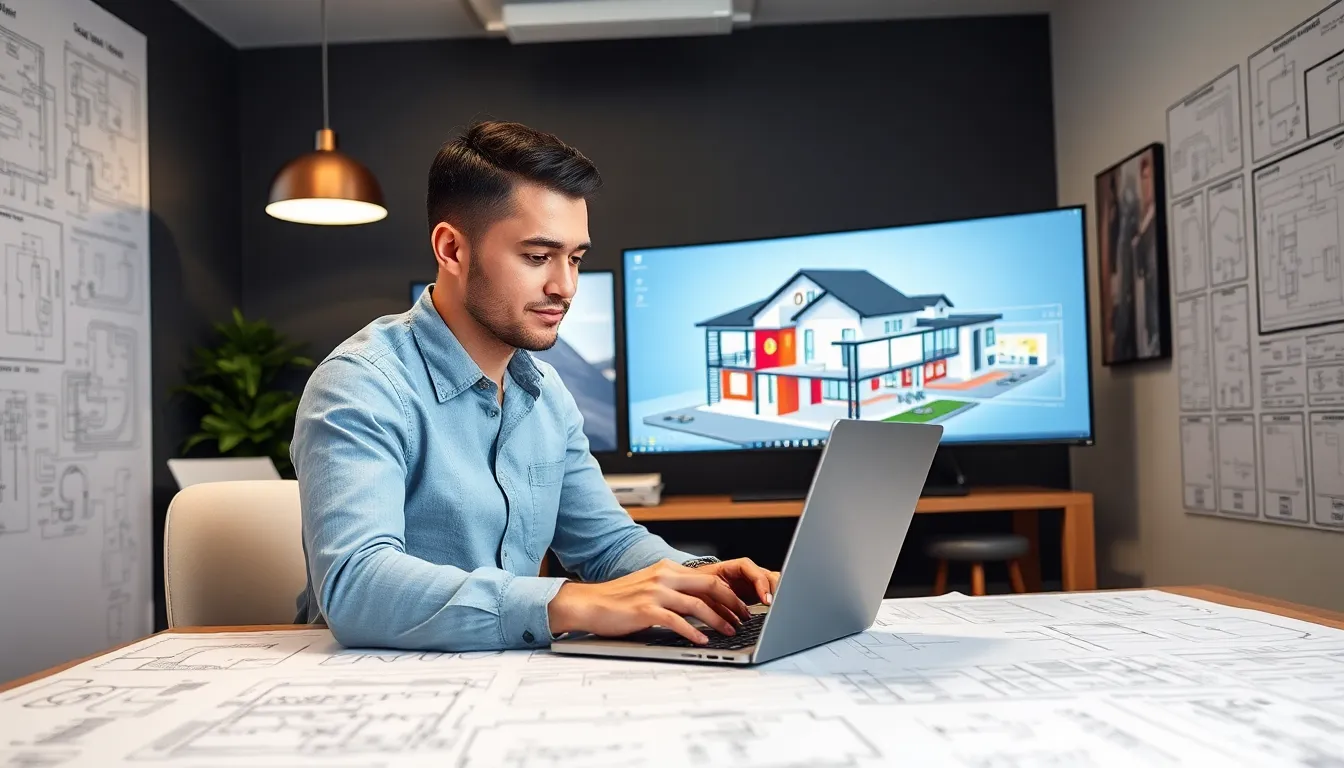When it comes to home design, most people think about paint colors and furniture layouts. But what about the unsung heroes of home comfort: electrical and plumbing systems? Enter home design software that tackles these critical elements with flair. Imagine crafting your dream home while effortlessly ensuring every wire and pipe is perfectly placed.
This isn’t just a techie’s playground; it’s a game-changer for DIY enthusiasts and professionals alike. With the right software, anyone can avoid the dreaded “oops, that’s not where I wanted that outlet” moment. So, buckle up and get ready to dive into the world of home design software that makes electrical and plumbing planning not just easy but downright enjoyable. Who knew wiring and plumbing could be this much fun?
Table of Contents
ToggleOverview of Home Design Software
Home design software provides tools for efficient planning of electrical and plumbing systems. Users can visualize layouts before committing to physical changes. Many programs offer drag-and-drop functionality for easy arrangement of fixtures and appliances.
Advanced features include simulation capabilities, allowing users to see how systems operate in real-life scenarios. Various software options cater to both DIY enthusiasts and professional designers. Budget-friendly solutions offer basic functionalities, while premium offerings provide detailed analysis and 3D rendering.
Some software packages integrate building codes and electrical standards, ensuring compliance during the design process. Visual aids, like color coding for different systems, enhance user comprehension. Collaboration tools allow multiple stakeholders to review and edit designs seamlessly. With these features, users minimize errors and streamline the decision-making process.
Comparing software options includes looking at user reviews, pricing, and compatibility with existing tools. Popular choices often come with extensive online resources and support communities. Tutorials and webinars can provide additional assistance for those unfamiliar with design software.
Effective home design software not only simplifies the integration of electrical and plumbing elements but also elevates the entire design experience. Enhanced planning capabilities lead to more functional and aesthetically pleasing spaces. Consequently, investing in reliable software proves beneficial for both short-term projects and long-term design endeavors.
Key Features of Electrical Design Tools

Electrical design tools come equipped with essential features that streamline planning and implementation. Their functionalities significantly improve the efficiency of creating electrical layouts and systems in home design projects.
Electrical Layout Planning
Electrical layout planning tools enable users to arrange lighting, outlets, and switches with precision. Drag-and-drop interfaces facilitate easy placement of elements within the design space. Users can visualize how electrical systems will function in real-time scenarios, enhancing decision-making. Flexible grid systems provide accurate measurements, ensuring placements meet safety standards. Color-coded symbols simplify tracking different circuit types and their specifications. These tools often include templates tailored for common layouts, expediting the design process for both novices and experienced designers.
Circuit Design Integration
Circuit design integration allows for seamless connection between electrical components and systems. Users benefit from features that simulate circuit performance before installation. Detailed analysis tools predict power loads, offering insights that help avoid overloads or code violations. Integration with local building codes ensures compliance throughout the design phase. Automatic updates alert users to any changes in the design or layout requirements. Collaborative features facilitate teamwork among electrical engineers and home designers, allowing real-time adjustments and sharing insights. Overall, these integration capabilities enhance the integrity and reliability of the electrical design process.
Key Features of Plumbing Design Tools
Plumbing design tools provide essential features for efficient system planning. These capabilities enhance both the design process and the final results.
Pipe Layout and Sizing
Pipe layout and sizing tools allow precise planning for various plumbing systems. Users can visualize pipe routes in 2D or 3D models, ensuring optimal placement. Customizable pipe sizes let designers adapt to specific project requirements. Accurate calculations facilitate the correct dimensions for water supply and drainage. Visual feedback highlights potential conflicts, such as interference with other systems. Simulation features predict water flow and pressure, helping users assess efficiency before installation. Clear representations of pipe networks streamline communication among team members.
Drainage System Planning
Effective drainage system planning is crucial for preventing water accumulation issues. These tools assist users in designing efficient drainage layouts tailored to property requirements. Users can model gravitational flow and identify key points for drain placement. Comprehensive simulations forecast drainage performance under various conditions, ensuring system reliability. Visual aids, including color-coded representations, enhance understanding of flow dynamics. Integration with building codes ensures compliance throughout the design process. Collaboration tools facilitate stakeholder input, promoting informed decision-making and optimizing designs. These features simplify drainage planning, making it more accessible and reliable for all users.
Benefits of Using Home Design Software
Home design software streamlines the planning of electrical and plumbing systems, enhancing overall project outcomes. Users experience several key advantages that make this technology indispensable.
Improved Accuracy and Efficiency
Enhanced precision occurs with home design software, as users accurately measure and position electrical and plumbing elements. Digital tools minimize human errors commonly made during manual planning. Features like drag-and-drop interfaces allow immediate adjustments to layouts, which saves time significantly. Advanced simulation capabilities present real-world scenarios, revealing potential issues before installation. Calculating materials and costs becomes straightforward with integrated databases, ensuring accurate budgeting. Visual aids color-code systems, which simplifies identifying components at a glance. Overall, users can expect a seamless design experience that promotes speed and accuracy.
Enhanced Collaboration with Professionals
Collaborating with professionals improves efficiency when using home design software. Multiple stakeholders can concurrently access and edit designs in real time. This feature allows architects, engineers, and homeowners to communicate effectively, fostering a comprehensive understanding of project requirements. Instant feedback becomes possible, reducing the chances of costly revisions later in the process. Many software packages include integrated messaging tools, facilitating discussions right within the planning environment. Stakeholders can leverage shared visual aids, ensuring everyone stays aligned throughout the project. Ultimately, this enhanced collaboration leads to stronger project outcomes that meet or exceed expectations.
Popular Home Design Software Options
Numerous software options facilitate the design of electrical and plumbing systems in homes. These programs cater to various needs, ranging from beginners to experienced professionals.
Software A
AutoCAD Architecture stands out among home design software tools. This robust program offers advanced features for creating detailed architectural plans. Users appreciate its extensive library of electrical and plumbing symbols, simplifying the design process. Customizable templates expedite workflow, particularly for intricate designs. Enhanced collaboration tools allow for real-time feedback among team members, improving project accuracy. Additionally, integration with building codes ensures compliance, reducing regulatory issues during construction. Overall, AutoCAD Architecture provides a comprehensive solution for professionals focusing on precise and efficient planning.
Software B
SketchUp is another popular choice in home design software. Known for its user-friendly interface, this program enables quick and intuitive layout planning. Users can drag and drop various elements, making electrical and plumbing installations straightforward. The 3D modeling feature allows for realistic visualizations, ensuring designs meet users’ expectations. Pre-built models of fixtures and appliances save time during the planning phase. Collaboration is seamless, as stakeholders can easily share projects and provide input. With its versatility and accessibility, SketchUp remains a top option for those seeking efficient home design solutions.
Home design software for electrical and plumbing systems is a game-changer for both DIY enthusiasts and professionals. By simplifying the planning process these tools enhance accuracy and efficiency while minimizing errors. Users can visualize their designs in real-time promoting collaboration among stakeholders and ensuring compliance with building codes.
With a variety of software options available there’s something for everyone from budget-friendly solutions to advanced programs with powerful features. Investing in the right home design software not only streamlines the integration of essential systems but also elevates the overall design experience. Embracing this technology leads to more functional and aesthetically pleasing spaces that meet the unique needs of each project.




